Bass (European Sea Bass):
- Season: April to November.
- Behavior: Bass are opportunistic predators and feed on a variety of prey, including small fish, crustaceans, and cephalopods. You can find bass all year round but the best time for them is when the temperature is at its warmest over the summer and autumn. Once the temperature reaches 12 degrees or more the Bass will move closer to shore and in larger numbers, the best time to hunt them is generally considered to be July to September when the temperature is highest (15-18 degrees). As temperatures start to cool in October, the Bass stick closer to shore, feeding heavily to prepare for winter, this is when you will tend to find the biggest bass.
- Size:
- The most common size for bass to be caught is around 45-65cm (2-6lb), Bass are often caught in sizes in excess of 6lb and it’s not unheard of people catching them up to 10lb.
- Distinct features:
- Bass are a beautiful fish and have small shiny silver scales which get darker up the body to the top of the fish. When looking from above it can be hard to tell if a Bass is a Bass or a Grey Mullet due to the dark blue/grey appearance, however bass have a slimmer head and overall slimmer appearance. The tail has a small fork but is less striking than that of a mullet. When Bass move the large dorsal fins tend to extend out with the spines pointing upwards which is a clear indication that it’s a bass not a mullet as the mullet have two much smaller fins.
- Where can you find them:
- The best places to hunt for bass is on rocky reef with kelp forests, they will use the kelp to hide from predators like seals and also to ambush prey such as small fish and crabs.
- Bass often patrol in very shallow water where the temperature is slightly higher, cruising through the tall seaweeds near the surface that we often refer to as string weed or wireweed.
- Bass also like areas with strong currents such as offshore pinnacles and reefs.
- Keep an eye out for bass cruising through sandy gullies through kelp forests.
- Hunting techniques:
- In shallow water when hunting from the surface, move very slowly, don’t make any noise or splashes and have your gun ready to shoot in the direction you are looking. By doing this you’re prepared to make a quick shot when you spot a bass hiding in the seaweed or around the rocks.
- One of the harder but most productive ways to hunt bass is to essentially do the above but underwater, we call this stalking the kelp and as you swim and hover over the kelp underwater you can spot bass hiding or scare them out of the kelp and ambush them. Use the gullies to your advantage and be ready to react quickly.
- Hiding in the kelp and calling the Bass to you is one of the easier ways to hunt bass, if you dive to the bottom and sit calmly on the seafloor hidden in the kelp you can make a grunting noise in your throat and often the schools of bass will come in to take a look and you can ambush them.
- Interesting facts:
- Bass can live up to 25 years and grow to a weight of over 7 kg (15 lbs).
- They are often called “sea wolves” due to their cunning hunting behavior, which involves working in groups to ambush prey.
- Regulations: Spearfishers can retain up to two bass per day during the season, with a minimum size limit of 42cm. There’s an outright ban on catching bass in February and March.
- Gear & safety tips:
- Gear: Use a mid-length speargun (70-85cm) for versatility, as bass often dart around rocks and kelp. We would recommend a lightweight single band speargun for areas with poor visibility and a twin 14mm band speargun for areas with better vis where you need more range and speed. We would recommend the Rob Allen Sparid or Snapper, Pathos Laser Evo Pro, Salvimar Ares Nightmare or Sigalsub Nemesis Pro.
- Safety: A float + line and dive flag are essential for safety when spearfishing in the UK, even if you’re very close to shore, if your spear or line gets tangled you can let go of the gun without having to worry or risk your safety.
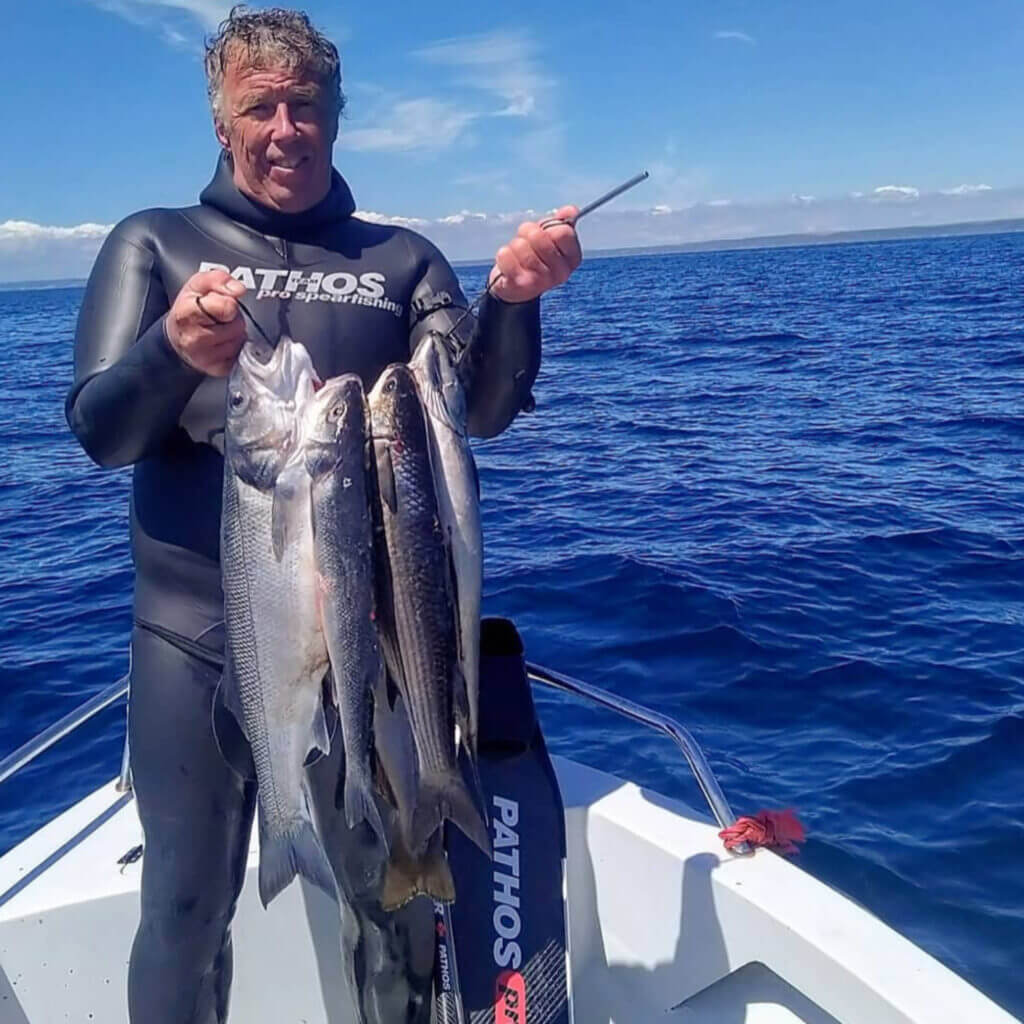
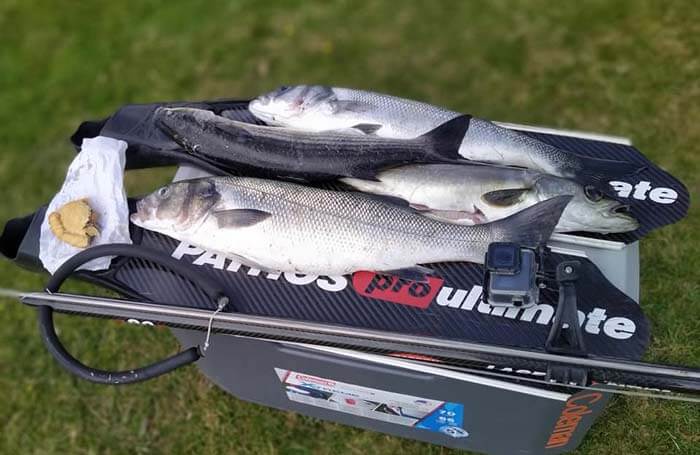
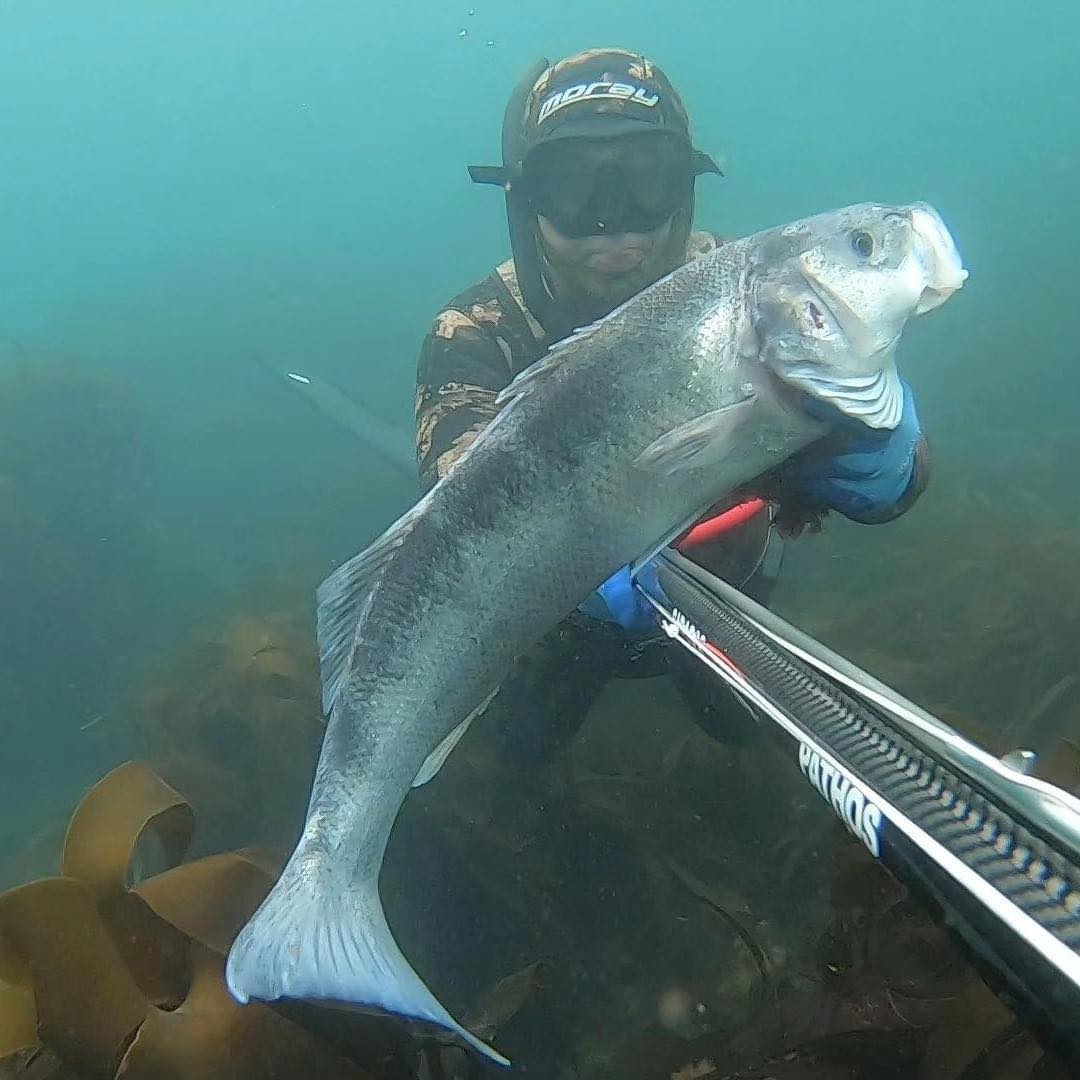
Grey Mullet:
- Season: All year round, one of the best species to hunt no matter the temperature or time of year.
- Behavior: Grey Mullet are strong swimmers and are often found in shallow coastal waters, estuaries, and harbours. They are known for their skittish nature, requiring patience and stealth from spearfishers. They can be found moving in schools and on their own grazing on seaweeds, most of the time in the top couple of meters of water.
- Size:
- The most common size for Mullet is around 40-55cm although it’s not unheard of to catch them up to around 65cm.
- Distinct features:
- Mullet have a streamlined body almost torpedo shaped with a forked tail. Large silvery-grey scales appear in a striped pattern when up close which is much more striking than Bass. They have a dark, blunt round head with large lips. Two small dorsal fins on top of the fishes back compared to the two large dorsal fins on a Bass.
- Where can you find them:
- Mullet often move in schools in very shallow water right along the shoreline, often in those places where you would think it’s time to unload your gun and get out of the water, one of the best times to hunt mullet like this is at the start of the year in Jan-March when the water is the coldest and in July & August when the water is warmest.
- Mullet will feed on seaweeds so you can often find them grazing on the tall seaweeds such as string weed and wireweed. or like bass swimming through the kelp gullies.
- Mullet can be found in deeper water and sometimes in schools of bass but you’re generally best looking for them in 10m or less depth.
- Mullet often like hiding in holes and caves or hiding under ledges in the kelp forests.
- Hunting techniques:
- Like Bass one of the best way to fish for Mullet is to stay on the surface in very shallow water and use the terrain to hide and ambush the fish as they move through the shallows. You often have to be very quick as they could be moving through in a school or you can use a stealthy approach to take a shot on an individual fish hiding or feeding in the seaweeds.
- Generally with Mullet they are quite skittish so you need to be on your A game to be proficient in catching them. Keeping your gun ready at all times and moving as silently as possible as you could come around the corner of a boulder in 2 feet of water and suddenly you’re faced with 10 mullet and a split second to react before they spook and swim away.
- Once you find mullet in an area there are often more so patrol the area carefully and you’re likely to bump into more mullet moving around and feeding.
- Interesting facts:
- Grey Mullet are primarily herbivorous, feeding on algae and detritus, though they also consume small invertebrates.
- There are actually a few subspecies of Grey Mullet, Thin Lipped, Thick Lipped and Golden Spot, the latter being the smallest and best eating.
- Mullet found in open water away from estuaries will often taste a lot better. Those caught in and around estuaries are often why this fish gets a bad reputation for its taste, however Grey Mullet are a fantastic fish to eat and have a meaty texture that goes well in a wide variety of recipes.
- They are equipped with gizzards, similar to birds, to help grind up their plant-based diet.
- Mullet are a favorite target for both spearfishers and anglers due to their challenging nature and strong fight when hooked.
- Regulations: The minimum size limit for Grey Mullet is 33cm.
- Gear & safety Tips:
- Gear: depending on your visibility a smaller speargun is generally better around 70-80cm in most places and smaller guns around 60cm in areas with low visibility, as mullet are very quick a lightweight but powerful speargun is ideal, a single band is adequate but you will often find a twin band or roller gun to have the required speed in order to spear a mullet at any range without the need to lead the fish as they swim. We would recommend the Rob Allen Sparid or Snapper, Pathos Laser Evo Pro, Salvimar Ares Nightmare or Sigalsub Nemesis Pro.
- Safety: Mullet do put up quite a fight for a small fish so using a float and floatline to secure your gun is often the ideal scenario.
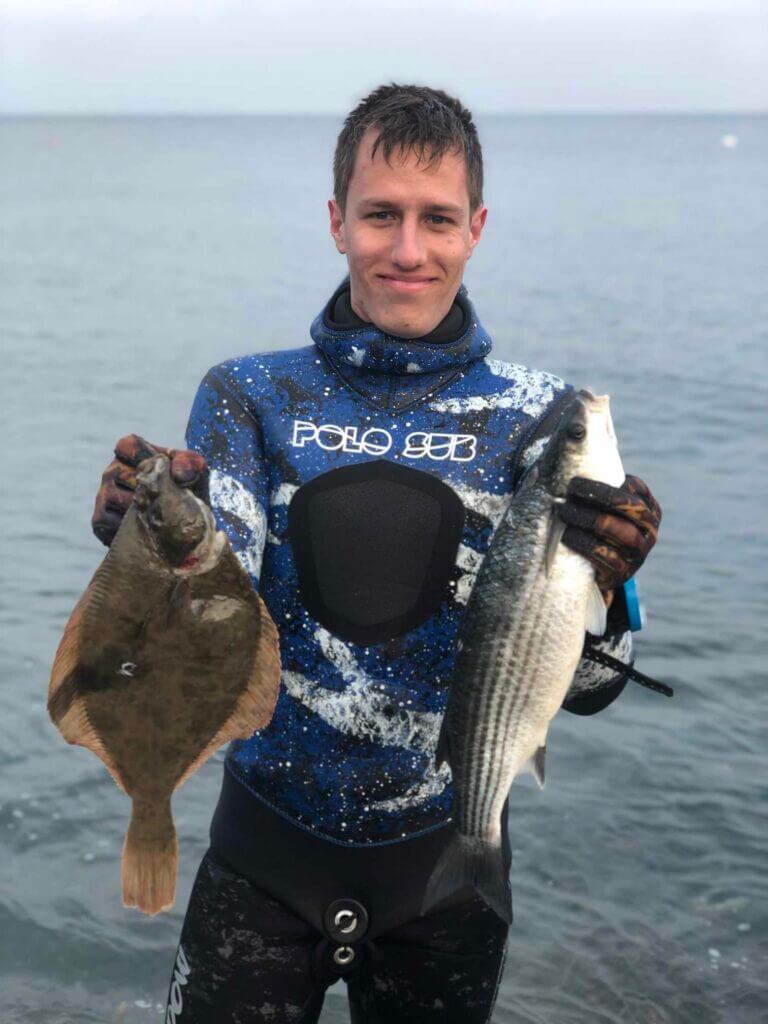
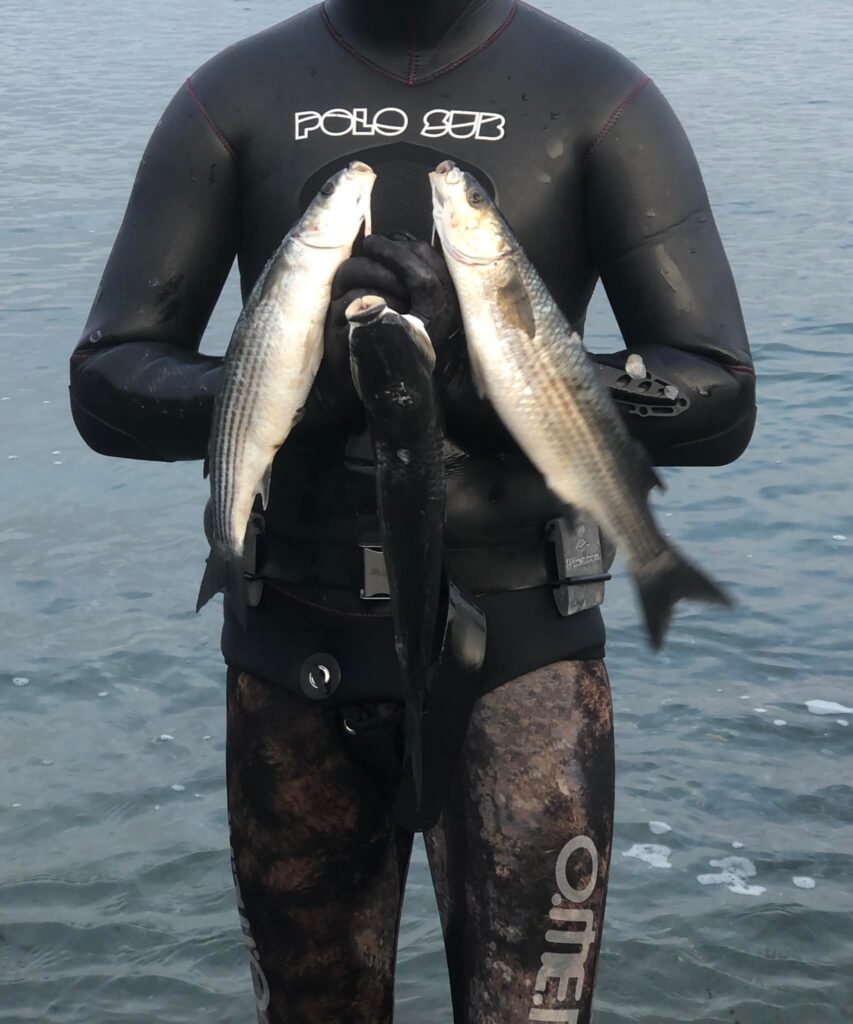
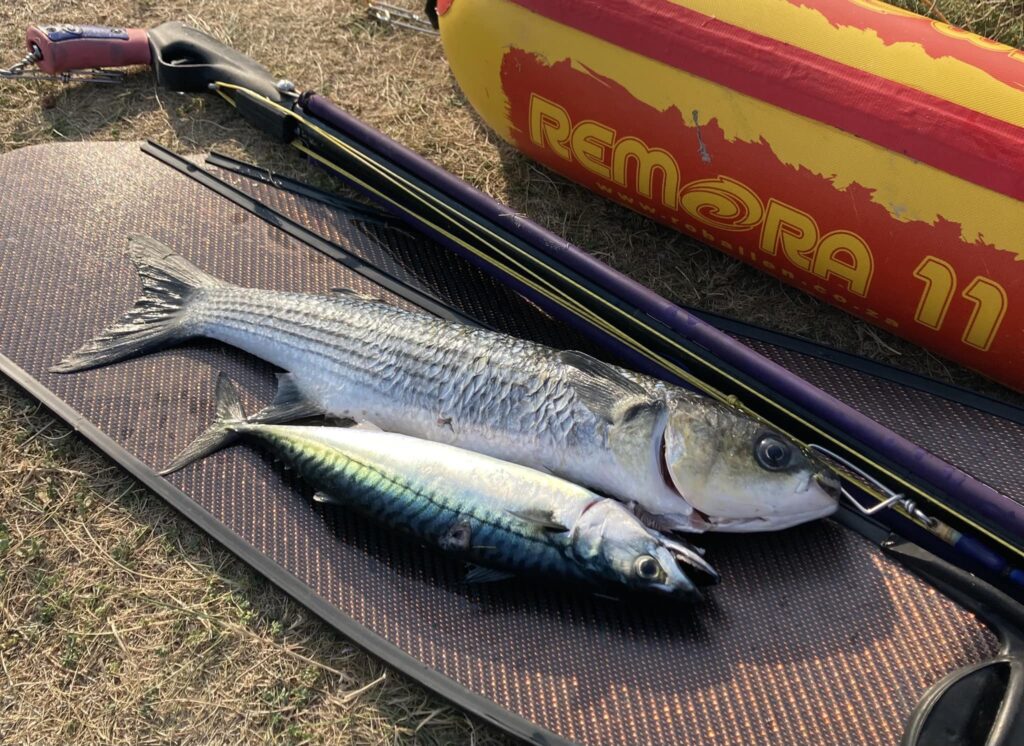
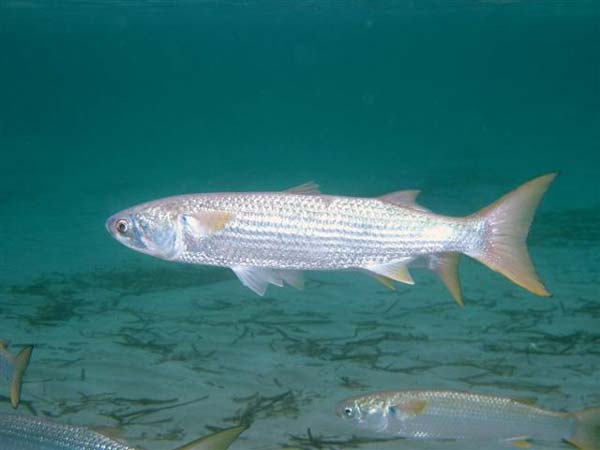
Pollack:
- Season: Pollack stick around all year round but are easier to find in late spring through summer and autumn.
- Behavior: Pollack are commonly found near rocky outcrops and kelp forests, where they ambush smaller fish. Larger pollack tend to move closer to shore in autumn, making September and October prime months for spearfishing.
- Size:
- Most common size is 40-60cm but on deeper pinnacles and offshore reefs it’s common to find them up to 80cm and up to 10lb in weight. Its not uncommon to see Pollack over 10lb being caught in Cornwall and Scotland.
- Distinct features:
- Pollack have a distinct lateral line along their side separating the dark and golden colours of their scales.
- Large deep black eye and large dark tail fin. Their scales are very small and is what gives them a very smooth and sleek appearance.
- Where to find them:
- Most Pollack in shallower water (below 10m) will generally be below 50cm in most areas, to find larger Pollack you often have to go a bit deeper towards 15m or more and find terrain like pinnacles and wrecks. The reason for this is that Pollack like structure and areas to hide so they can ambush their prey, often areas with current will be more favorable for them especially offshore pinnacles and reefs.
- Hunting techniques:
- Pollack are extremely well camouflaged in the kelp due to their brown/golden colour, this means you often need to work harder to find them. One of the best ways to hunt for them is to dive to the bottom and hide in the kelp, make the grunting/grouper call sound in your throat and they will often come to investigate.
- In areas with current it’s best to hunt on slack tide between the tides so the current is at its slowest, this means the fish are less likely to be hiding in the kelp and will be more active, moving around the reef, giving you a better chance at finding them.
- Pollack are not so easily spooked as bass or mullet but once you have fired your gun it will likely scare them into the kelp or make them move deeper. If you move around the area as you hunt your less likely to scare the same few fish away as you will notice the more dives you do in the same spot the fish will become more wary of you.
- Interesting facts:
- Pollack are known for their striking golden-yellow lateral line, which contrasts with their darker back.
- They are a close relative of cod and haddock and are often used as a sustainable alternative to cod in cooking.
- Pollack are masters of camouflage, blending in with their surroundings to evade predators and hunt prey.
- Regulations: The minimum size limit for Pollack is 35cm.
- Gear & safety tips:
- Gear: A longer speargun around 80-100cm is recommended for targeting pollack in deeper water and open spaces. Ideally twin bands or a roller for speed and added range.
- Safety: Pollack often inhabit rocky, kelp-rich areas. Always check for entanglement hazards and it’s essential to practice proper dive-buddy techniques when exploring deeper areas.
- Doing training to increase your breath hold is very important for hunting pollack safety as you’ll often be doing repetitive dives to deeper depths which increases the danger.
- If diving in current it’s advised to study the area and make informed plans about your dive site with your buddy, taking a PLB, phone or gps with you and advising people of where you are is key in case you run into trouble.
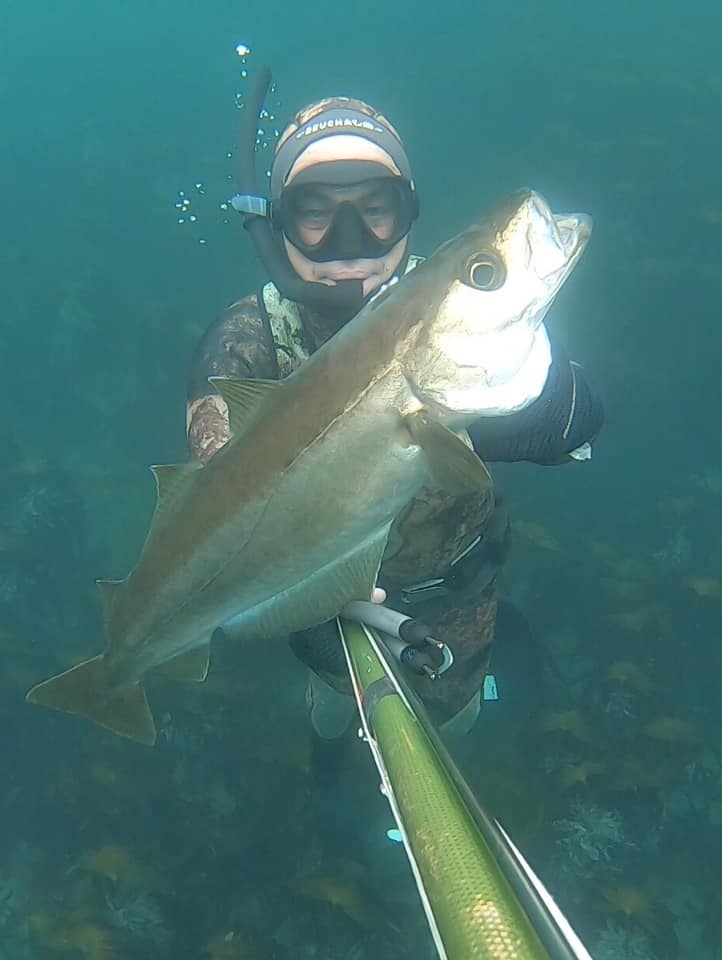
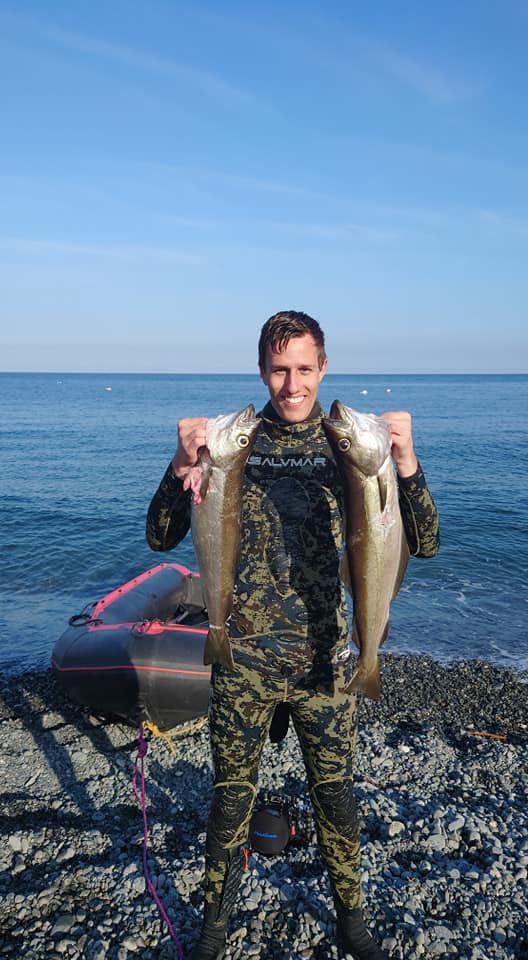
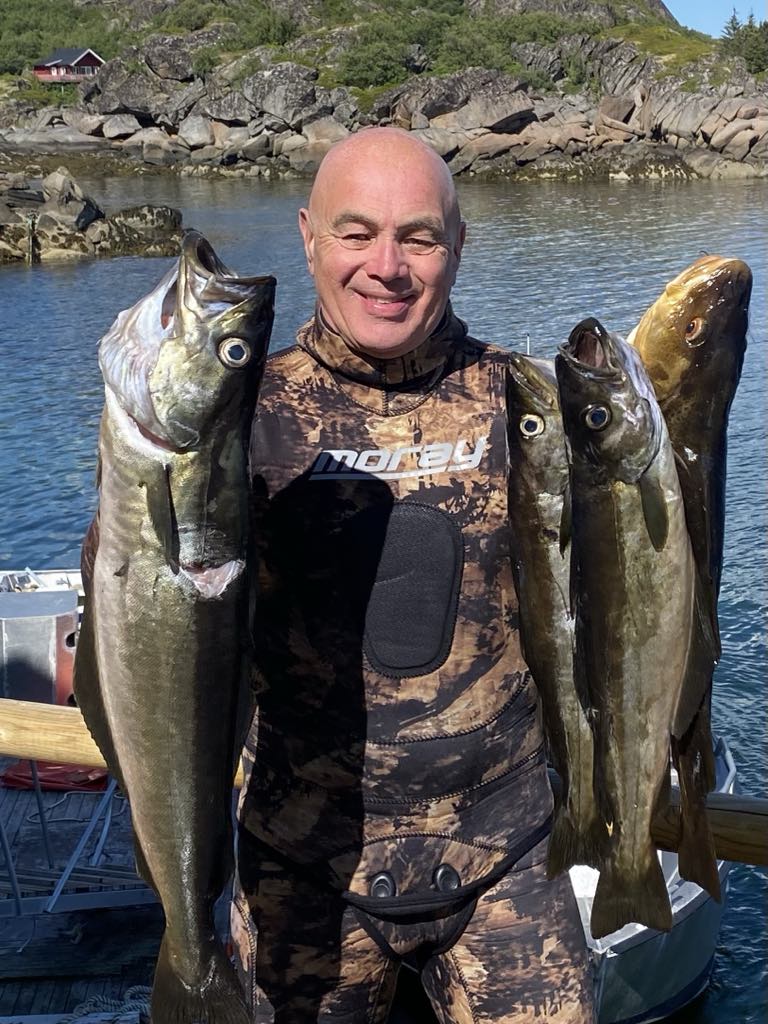
Bream (Black Bream):
- Season: Spring and summer months.
- Behaviour: Black bream are nesting during spring, so it’s advisable to avoid spearing them then to protect their young. During the summer months, they are more active and offer an exhilarating hunt. They are quite skittish and often move in schools, they favor rocky ledges in 10-20m of water.
- Size:
- Bream are generally smaller than Bass or Mullet, they have a rounder appearance, you will generally find them around 30-50cm and it’s rarer for divers to find fish around the 60cm mark. Although it does not grow to any great size, the black bream is generally regarded as a particularly tricky and prized fish to catch.
- Distinct features:
- Teardrop shape with small tail and dorsal fins, dark grey scales, small mouth and eyes.
- Where to find them:
- Less common in Cornwall and the more common in Devon, Dorset and further east. You need a bit of depth for Black Bream, 10-25m generally, pinnacles, wrecks and rocky ledges are a good place to look, areas such as Portland and the Eddystone lighthouse are commonly dived for Black Bream.
- Hunting techniques:
- Tricks such as scratching up the mussels or throwing up shale and pebbles can work but generally stealth is your best option.
- They wont tend to come close so you need to have a longer gun and be confident with your aim.
- Stalking and creeping around ledges and edges of reef similar to how you see people hunt for snapper in New Zealand.
- Using current to your advantage to position yourself in a prime opportunity to ambush
- Interesting facts:
- Black bream are known for their vibrant, shimmering scales, which reflect sunlight underwater.
- Males build and guard nests during the breeding season, often displaying territorial behavior.
- They are omnivores, feeding on small invertebrates, crustaceans, and algae.
- Regulations: The minimum size limit for Black Bream is 23cm.
- Gear & safety tips:
- Gear: A speargun with good maneuverability (75-90cm) is suitable for targeting bream in rocky or reef habitats. It’s often preferred to use a gun around 80-100 in order to get the added range you need, often twin bands or a roller as the fish is small you need to be quick.
- Safety: Be cautious when diving near reefs where currents can be unpredictable. Always carry a dive knife and dive with a float & practice proper buddying.
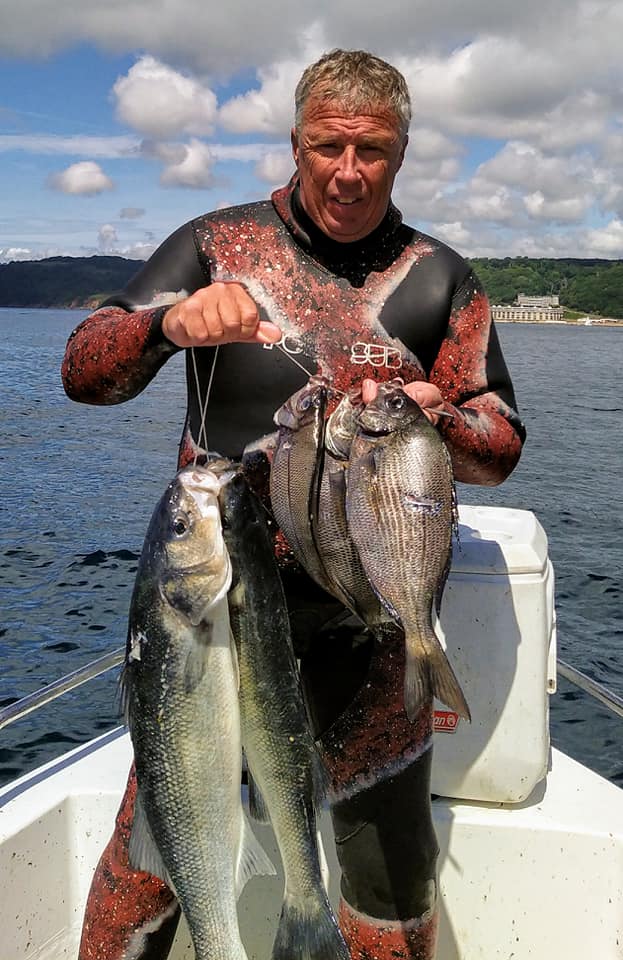
Gilthead Bream:
- Season: Late spring through early autumn.
- Behavior: One of the most prized catches by spearfishers in the UK, Gilthead Bream are typically found in warmer, shallow waters near seagrass beds, estuaries, and rocky reefs. They are powerful swimmers and can be elusive, requiring a careful approach and precise aim. These fish are omnivores and prefer small crustaceans and shellfish, in particular muscles.
- Size: Similar to Black Bream but slightly larger, anything from 1-6lb, 35-60cm are most common.
- Distinct Features:
- Unmistakable golden bar on the forehead/above the eyes of the fish.
- Teardrop shape, muscular build.
- They have strong jaws for crushing shells and powerful fins giving them great speed in bursts.
- Where to find them:
- Giltheads are very difficult fish. They favour deep water and flat bottoms with little or no cover. They will often be seen hanging behind a shoal of black bream, being even more cautious.
- They can often be found hiding in schools of bass or mullet or in and around estuaries feeding on shellfish.
- Muscle beds and offshore reefs and pinnacles are a common favorite of the Giltheads but divers do find them inshore in kelpy reef and seagrass.
- Rocky ledges similar to Black Bream.
- Hunting techniques:
- Giltheads are fast moving, powerful and very nervous so you need to be stealthy and quick.
- If you lock eyes with them they will spook instantly.
- Positioning yourself in the right place and right time is a big part of the luck of the draw when hunting these fish, being ready at all times to ambush them, generally using a longer powerful gun to catch them.
- Interesting facts:
- Gilthead Bream are named for the golden band between their eyes, which resembles a gilded crown.
- They are hermaphroditic, starting life as males and later transitioning to females as they mature.
- Known for their delicious, firm, white flesh, they are a prized catch for both spearfishers and anglers alike.
- Regulations: The minimum size limit for Gilthead Bream is 20cm in most areas, but it’s essential to check local regulations as they can vary.
- Gear & safety tips:
- Gear: Use a mid-length speargun (80-90cm) with a sharp, barbed spearhead to ensure a secure catch, as Gilthead Bream are robust and fast-moving. Often longer guns are preferred in order to catch these fish due to their speed and nervous behavior.
- Safety: Gilthead Bream are often found in areas with strong tidal flow, such as estuaries. Be cautious of currents and always use a dive flag to alert other water users to your location.
- Tips: Patience is key when hunting Gilthead Bream. Their keen senses and agility mean they are easily spooked, so approach quietly and avoid sudden movements.
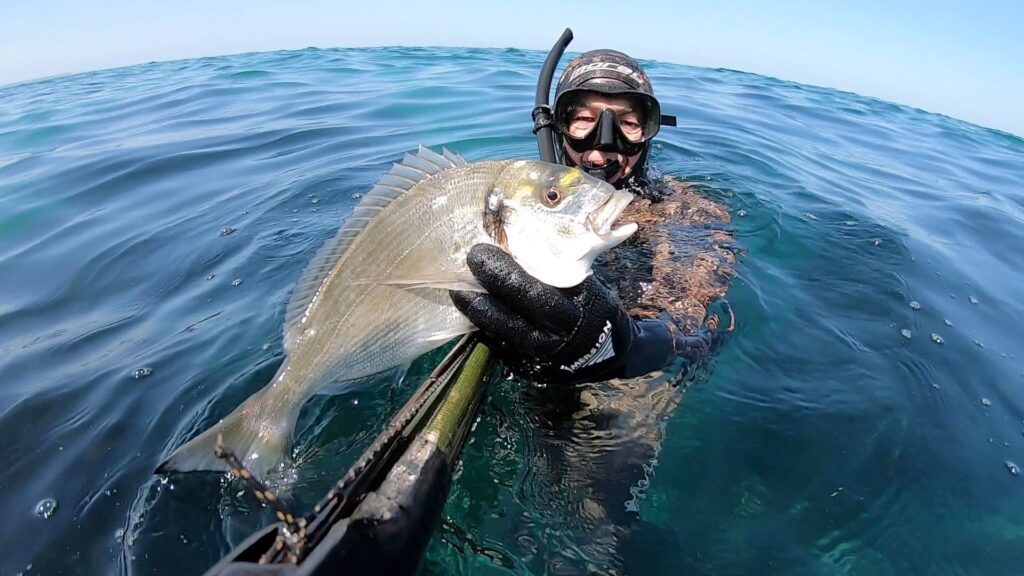
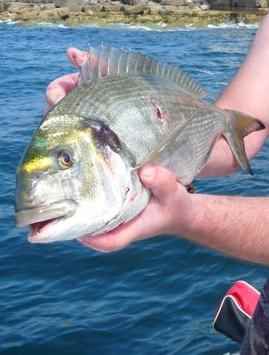
Flatfish (e.g., Flounder, Plaice, Sole):
- Season: Flounder can be spearfished year-round, while other flatfish species are more abundant during the warmer months.
- Behaviour: Flatfish are masters of disguise, burying themselves in the sandy seabed to avoid predators and ambush prey. Plaice are particularly active during the summer months on the fringes of kelp beds and sandbanks.
- Size:
- Most flatfish will be around 30-45cm, with Plaice and Turbot being the largest. Often experienced divers will find plaice in excess of 60cm.
- Distinct features:
- Plaice – Large yellow spots and a more curved diamond shape, smooth skin.
- Turbot – Large round body with spotted and speckled skin.
- Flounder – Square cut tail fin, similar shape and spots to Plaice and is often misidentified.
- Sole – Distinctive hooked mouth and sole shape.
- Where to find them:
- Generally flatfish are found on sandy, muddy and broken ground on the edges of reef and in and around estuaries.
- Flounders are by far our most numerous flatfish and are certainly the one most often caught by spearfishermen. To find flounders swim in shallow water 1-4m deep. Where the water is clear enough, look for them buried or resting in the sand or mud. They like to lie near seaweed covered rocks. When buried, look for the eyes and mouth sticking out of the sand. They have good camoflage and can be a variety of colours.
- Turbot are a very unusual catch. They are not often found, and will tend to be sat on a bank or in a depression. You will spend many hours looking for these fish, but if you are lucky enough to find one they are a real prize, growing to in excess of 30lbs.
- Everything said about Flounder applies to Plaice. In addition you will find them sitting in the open on the mussle beds. This tends to be deeper diving and requires more experience and effort.
- Hunting techniques:
- Where the water is clear enough, look for them buried or resting in the sand or mud. When the water is murky, dive to midwater and swim parralel to the seabed about 2m above the bottom, looking carefully for the hidden shape and outline of the fins or eyes.
- Often early morning or late evening is best as they often move at night when theres less chance of being seen by predators, they will also move closer to shore and in bigger numbers on a full moon and big tides.
- Interesting facts:
- Flatfish begin life with both eyes on each side of their head. As they mature, one eye migrates to the other side, giving them their distinctive flat appearance.
- Plaice are known for their bright orange spots, which are believed to serve as camouflage and a warning to predators.
- Flounder can tolerate a wide range of salinities, often venturing into brackish waters of estuaries and rivers.
- Regulations: Minimum size limits vary by species:
- Flounder: 27cm
- Plaice: 28cm
- Sole: 25cm
- Gear & safety tips:
- Gear: Use a pole spear or smaller speargun (50-70cm) for targeting flatfish in shallow, sandy areas. A flashlight can help spot them when visibility is low.
- Safety: Flatfish are often found in shallow waters, but tides can quickly change. Be aware of tide schedules and avoid getting caught in rip currents.
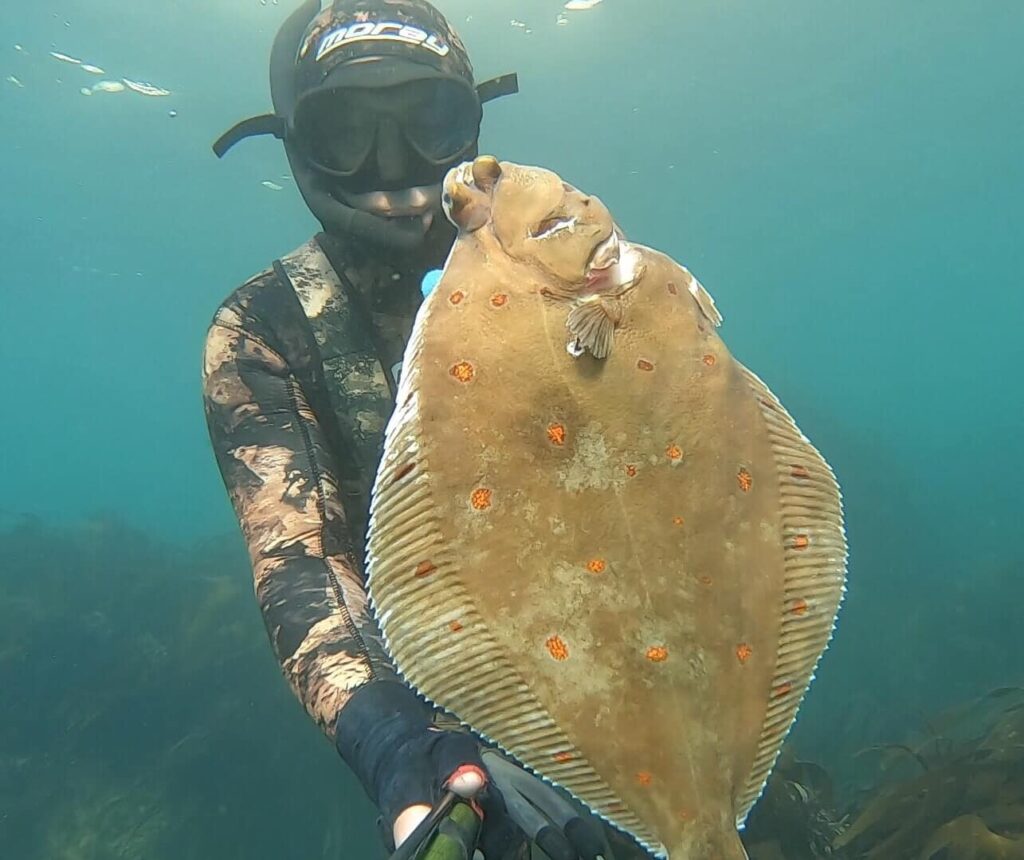
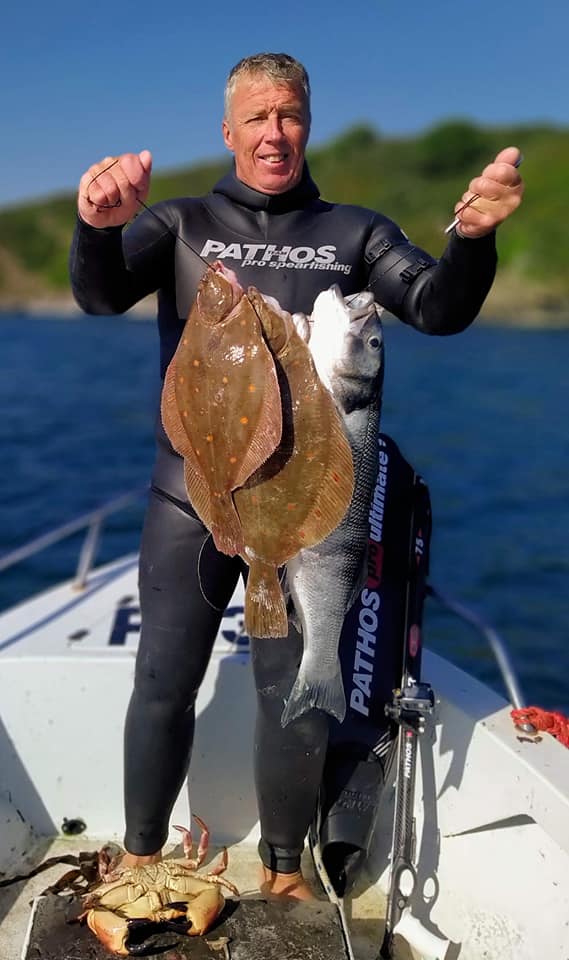
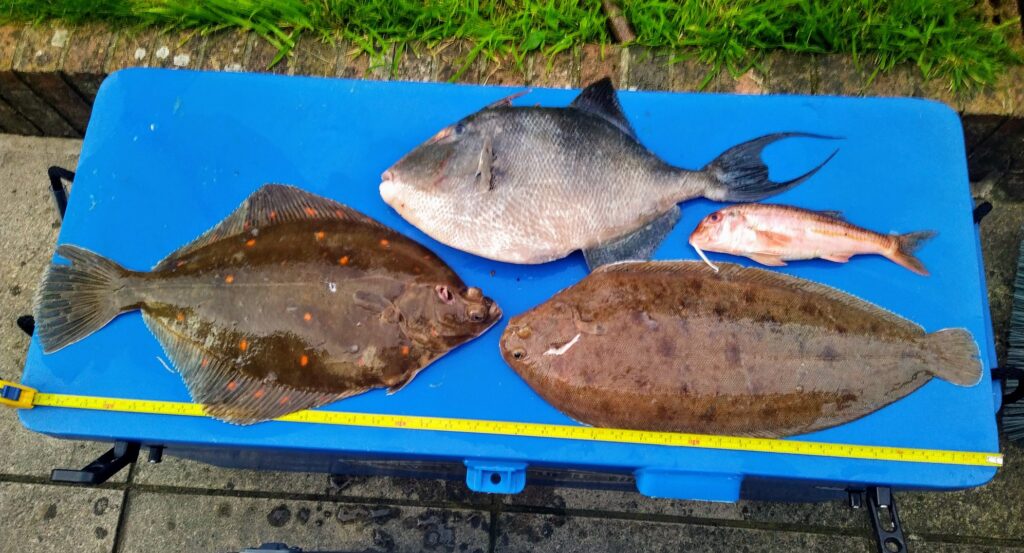
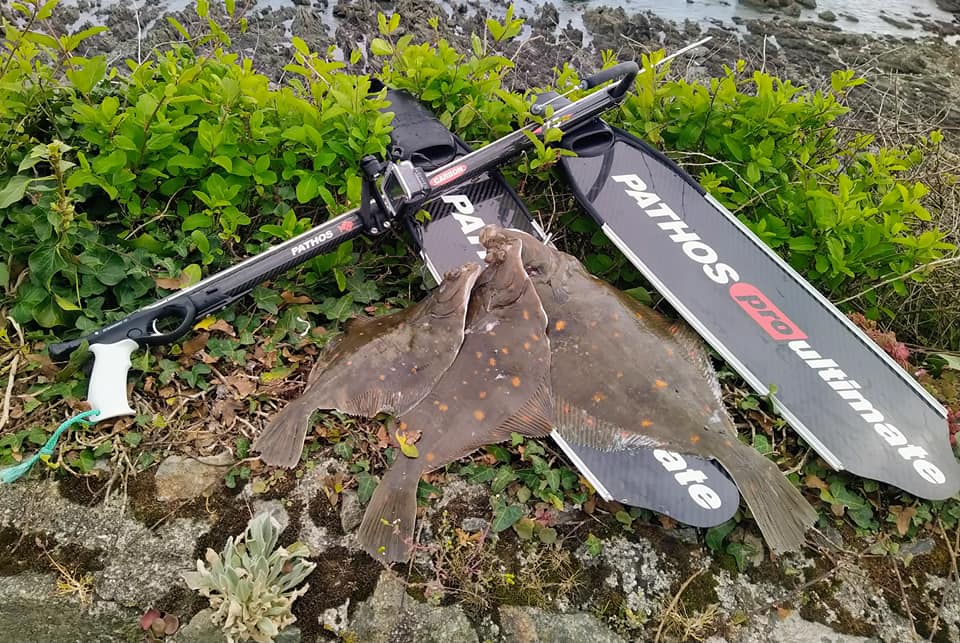
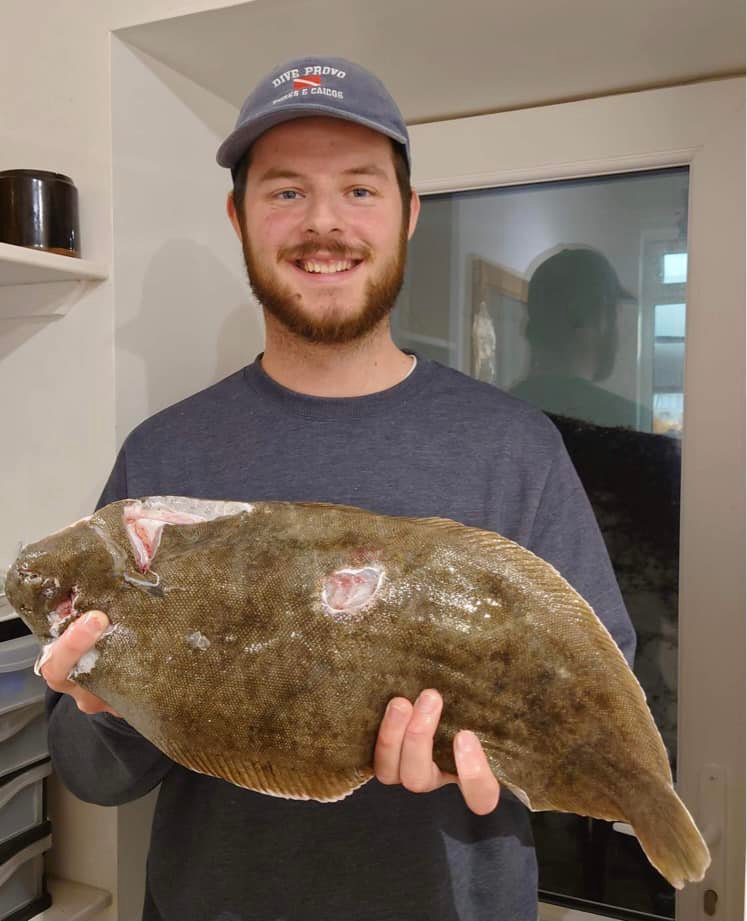
Grey triggerfish:
- Season: Triggerfish migrate here in Late summer to early autumn.
- Behavior: Grey Triggerfish are often found around wrecks, reefs, and rocky areas, particularly in warmer waters. They are inquisitive and can sometimes approach divers out of curiosity, but their tough skin and strong jaws make them a challenging yet rewarding target for spearfishers.
- Size: Similar to Bream but slightly larger, anything from 1-6lb, 35-60cm are most common.
- Distinct features:
- Unique shape, large eye and toothed jaws. Large tailfin. Trigger dorsal fin.
- Where to find them:
- Rocky ledges and cracks in reef, similar to when looking for lobster or conger eels.
- Cracks in reef as the rock meets the sand.
- Hunting techniques:
- It’s common to find them around estuaries or on kelp beds, once spotted if they spook you can follow them into the cracks in the reef where no doubt more will be hiding.
- Using a small gun with a strong spear and a torch to search and shoot into cracks in the reef.
- Interesting facts:
- The name “triggerfish” comes from their dorsal fin mechanism. The first spine can be “locked” upright by the second spine, and the fish “triggers” it to lower the fin.
- They are equipped with strong teeth and jaws, capable of crushing hard-shelled prey like crabs and sea urchins.
- Grey Triggerfish are known for their vibrant colors, often displaying shades of blue and green with intricate patterns on their fins.
- Regulations: Minimum size limits for Grey Triggerfish vary, but they are not as heavily regulated as some other species. Always check local guidelines before targeting them.
- Gear & safety tips:
- Gear: A torch and a sharp spear tip is essential, as their tough skin can make penetration difficult. A mid-length speargun (75-90cm) is recommended for accuracy and maneuverability around reef structures.
- Safety: Grey Triggerfish can deliver a strong bite, so handle them with care. Use gloves when removing the spear or handling the fish to avoid injury.
- Tips: Aim for the head to ensure a clean shot, as their thick scales and skin can make body shots less effective.
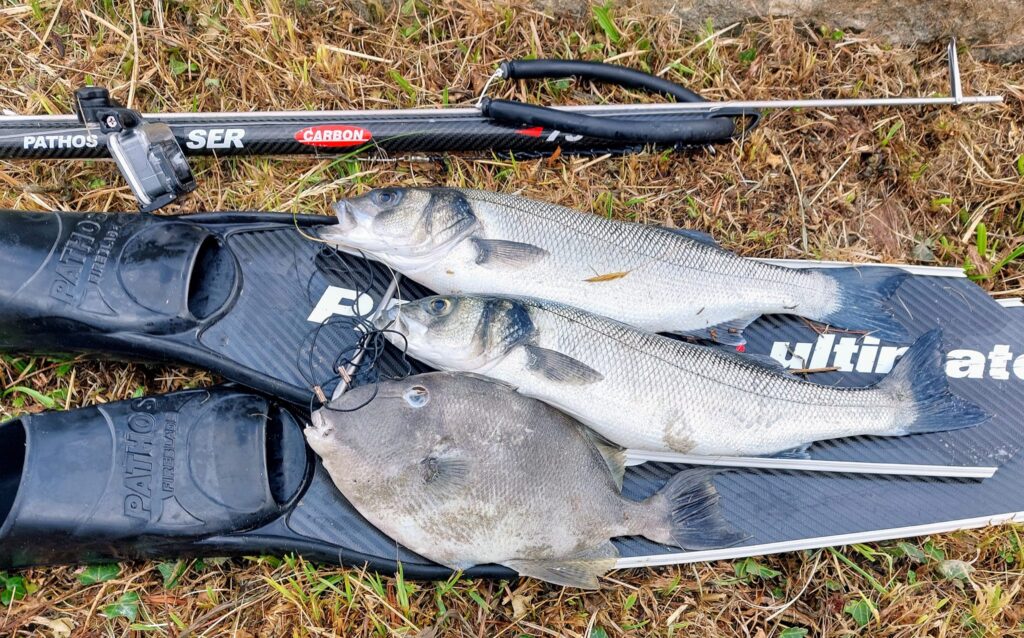

Local hotspots for spearfishing these species in the UK
- Bass (European Sea Bass):
Bass are abundant along the south and southwest coasts of England, with Cornwall, Dorset, and Devon being prime locations. Chesil Beach and the rocky coastlines around Portland Bill are particularly renowned. Look for bass near kelp forests, reefs, and estuary mouths, especially during an incoming tide. - Grey Mullet:
Popular spots for grey mullet include rocky coves, near estuaries, and sheltered bays. Locations like the the shallow areas of Pembrokeshire, Devon & Cornwall offer great opportunities. The clarity of the water in these areas is often ideal for spotting this skittish fish. Generally like Bass Mullet can be found almost everywhere. - Pollack:
Pollack thrive near wrecks, deep pinnacles, rocky outcrops, and kelp beds. Offshore reefs in Cornwall and the south coast are perfect, Scotland’s western coastlines, such as Oban and the Inner Hebrides, are excellent locations for targeting pollack. Diving deeper, around 10-20 meters, is often necessary to find the larger specimens. - Bream (Black and Gilthead):
For black bream, head to the rocky reefs and inshore waters of the South Coast, particularly around Sussex, Brighton, and Weymouth. Gilthead bream can be found in similar areas but are more commonly encountered in estuaries like the River Exe and the Taw-Torridge estuaries in Devon. Warm waters in late spring and summer increase your chances. - Flatfish (Flounder, Plaice, Sole):
Flounder are abundant in estuaries and sandy flats, they are very common across the whole UK and especially on the south coast. Plaice and sole are best targeted in shallow sandy bays or nearshore sandbanks, with the south coast of England being especially fruitful. - Grey Triggerfish:
Found around wrecks and reefs along the warmer waters of the south coast, grey triggerfish are a rarer but rewarding catch. Popular hotspots include Cornwall’s rocky coves and the areas around Plymouth and Falmouth. Triggerfish sightings tend to increase during warmer late summer months.
Cleaning and cooking tips for spearfishing catches
- Bass (European Sea Bass):
- Cleaning: Gut and scale bass promptly after catching. Their firm flesh makes them easy to fillet.
- Cooking: Bass is highly versatile and excellent grilled, pan-fried, or baked. A classic preparation is to bake it whole with lemon, garlic, and fresh herbs like thyme or parsley.
- Grey Mullet:
- Cleaning: Mullet can have a strong odor due to their diet, so clean them thoroughly, removing all gut material and rinsing well. It’s often best to remove the red meat from the fillets as this can be overpowering in taste, this is the bloodline that runs along the spine.
- Cooking: Best cooked fresh. Marinate fillets in citrus or herbs, then grill or smoke them for a rich flavor. They’re also popular in Mediterranean dishes like bouillabaisse.
- Pollack:
- Cleaning: Pollack have softer flesh, so take care when filleting. Remove the dark bloodline for the best flavor.
- Cooking: Pollack’s delicate texture works well in fish stews, chowders, or simply pan-fried in butter with a squeeze of lemon. It can also be battered and fried as an excellent alternative to cod in fish and chips.
- Bream (Black and Gilthead):
- Cleaning: Scale and gut bream carefully. Their smaller bones require attention when filleting, but cooking them whole is also common.
- Cooking: Black bream is excellent baked or grilled with olive oil, rosemary, and garlic. Gilthead bream pairs wonderfully with Mediterranean flavors – try stuffing it with fennel, lemon, and dill before grilling.
- Flatfish (Flounder, Plaice, Sole):
- Cleaning: Flatfish are easily cleaned by cutting around the edge of the skin and peeling it back, followed by filleting. They are often cooked with the skin on for added flavor.
- Cooking: Flounder is fantastic when pan-fried in butter, while plaice and sole are delicate and best lightly grilled or poached. A classic sole meunière, with lemon and brown butter, is a timeless dish.
- Grey Triggerfish:
- Cleaning: Triggerfish require a sharp knife to pierce their tough skin. Cut along the dorsal fin and peel back the skin before filleting.
- Cooking: The firm, white flesh of triggerfish is similar to shellfish in flavor and texture. It’s perfect for grilling, frying, or even as ceviche. Marinate it in lime and chili for a refreshing twist.
Conclusion
By exploring the unique behaviors and habitats of each species, alongside local hotspots and sustainable spearfishing practices, you can enhance your underwater adventures while respecting marine ecosystems. From the elusive bass to the golden Gilthead Bream, and even the tough-skinned Grey Triggerfish, each catch provides not only a thrilling hunt but also a delicious meal that connects you to the ocean.
Spearfishing is more than a sport – it’s a way to immerse yourself in nature, challenge your skills, and celebrate the bounty of the sea responsibly. Always follow local regulations, fish sustainably, and enjoy the experience of connecting with the underwater world.
